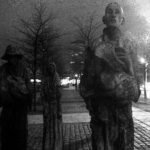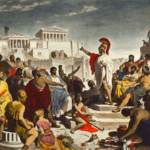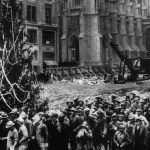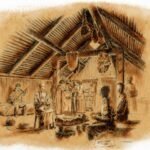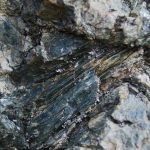Perth in Western Australia is sometimes mistaken for Perth in Scotland, and it happens for a reason. In fact, James Stirling, the first governor of Western Australia, named the city after Perth, Scotland in the year 1829 in honour of the birthplace of Sir George Murray, who was the Secretary of State for War and the Colonies, and held that position in the British House of Commons in Perth, Scotland. However, the history of Perth, Western Australia dates back to much earlier, the Aboriginal times.
Recommended Reading
The History of Christmas
The Great Irish Potato Famine
Boil, Bubble, Toil, and Trouble: The Salem Witch Trials
Aboriginal history
In the past, the native Aboriginal Noongar people lived in the south-west of Western Australia and called the area where Perth stands now Boorloo. They were occupying a significant territory, which spread out between what is now Geraldton to Esperance. As the archaeological remains found in Upper Swan have shown, Indigenous Australians have been in the Perth area for around 38,000 years.
Indigenous Australian people formed a hunter-gatherer community that consisted of 14 different groups who spoke a few different languages and many dialects. From about thirteen languages and dialects spoken in the past, only five remain today. The majority of modern Noongar people speak Australian Aboriginal English language, which is simply a mixture of English and Noongar words.
The estimated number of the Noongar population before European people arrived is from six to twenty thousand people. Initially, the Noongar community welcomed the British people; however, conflicts arose, as there were disagreements over land ownership, leading to hostility and violence. New diseases also accompanied the colonisation of the Aboriginal land by the British people.
The rights of the Aboriginal people
In the early years after the Europeans arrived in Perth, a person who played a big role in protecting the rights of Aboriginal people was Rosendo Salvado. After his arrival in 1846, Rosendo Salvado promoted the humane treatment of the Aboriginal people in Australia and supported their desire to maintain their authentic culture and traditions.
However, in 1905, the Aboriginal Act was passed, which put the survival of Aboriginal people and their culture under a huge risk. The Aboriginal Act resulted in institutionalised racism and allowed the establishment of Aboriginal “concentration camps”, where Aboriginal people were to be confined until their race almost vanished. Aboriginal children were taken away from their parents who were considered to be socially incapable of raising their children. The removal of Aboriginal children from their families continued until the 1970s.
In 1911, the Aborigines Act Amendment Act was passed, which empowered the Australian Federal and State government agencies to take mixed-race children, who had European fathers and Aboriginal mothers, away from their mothers. Some historians argue that the removal of mixed-race children was enforced in order to protect them from abuse and neglect in the Aboriginal community. Approximately 10 to 25 % of Aboriginal children were forcefully taken away from their families during those years, this phenomena is known as the Stolen Generations.
Things got better for the Aboriginal people after the Native Welfare Act of 1954, which was amended later in 1963. The Native Welfare Act repealed all previous legislation directed towards the unfair treatment of the Aboriginal people. However, only after the amendments in the Native Welfare Act in 1963, the Australian Federal and State government agencies had to stop the removal of Aboriginal children from their biological parents.
European Exploration
Since the formation of the British colony in Eastern Australia in 1788, European people were aware of the existence of the area on the western coast of Australia with its natural resources. Nevertheless, it still took a while before they got interested in exploring further to the West.
In the year of 1697, Dutch captain Willem de Vlamingh discovered the Swan River during his expedition, but did not see any potential in the land. After Willem de Vlamingh, there were several other expeditions by the French people in 1801 and the British people in 1822. Each time, the captains and their crew were not interested in settling in the area due to its poor soil and natural conditions.
In 1827, James Stirling entered the Swan River, where he saw the potential for the Indian Ocean trade and decided to found the Swan River Colony. He said that Perth was “as beautiful as anything of this kind I had ever witnessed”. He believed that the region was perfect for a settlement and convinced the British government to establish a colony there, which would be independent of the New South Wales colony.
Perth was founded on the 12th of August in 1829, on this day, James Stirling’s wife cut down a tree on the site of Kings Park to mark the event. The settlers arrived in 1829 prior to any establishments or land allocations. The Government started rapidly selling the land to settlers for cheap, disregarding the rights of Indigenous people. Perth, Fremantle, and Guildford were the first towns founded. Perth had an administrative and military function, Fremantle became a port, and Guildford was an agricultural centre.
Early 19th century
During the early years from 1830 to 1850, many changes happened to Perth and the surrounding area in Western Australia. Gradually, Perth took shape of a town. As expected, the allocated land was not fertile enough, and the settlers moved further to the Avon Valley to explore richer soils.
The poor soil combined with a lack of investment in the new colony made the progress of settling during the first few decades extremely difficult. Over the time, other towns like Kelmscott and Mandurah were developed. In the early 19th century, the main regulatory buildings were established, such as the first prison, court, church, and, surprisingly, brewery. The relationship between Aboriginal people and the settlers remained hostile at that time.
Since the construction and town development in and around Perth began and started taking up most of the space, Aboriginal people were forced to move further away to the surrounding areas, including the areas of the swamps and lakes. Aboriginal people resided there for a few decades, occasionally being joined by travellers, homeless people, and during the Gold rushes, by immigrants who were hunting for gold.
The Convict Era
The Convict Era (1850 – 1868) began when business and farmer people requested some cheap labour. Since the Perth area became a penal colony, about 9000 convicts were involved in a construction to build the city. This was the time when Perth as a city began growing rapidly. Gothic-style buildings that were common in Britain started to arise around Perth. Some of them remain as historical sites until today, such as Fremantle Prison, the Perth Town Hall, Government House, the Swan River Mechanics’ Institute, and others.
Latest Society Articles
Who Invented Democracy? The True History Behind Democracy
Medieval Fashion: Tunics, Underclothes, Pointed Shoes, and More!
37 Underground Cities: The Hidden Pillars of Civilization
Late 19th century
In the last two decades of the 19th century, the Perth area started developing materially. The first Perth telegraph line from Adelaide was finished in 1877, which improved the communications within the region. The railway construction from Fremantle to Guildford was completed in 1881. In 1885, the first newspaper named the Western Mail was published, and Western Australian gold rushes began the same year. The governmental buildings continued to arise in the city making Perth and the metropolitan area livelier.
Western Australian gold rushes lasted from 1885 to 1901. As the Kimberley, Kalgoorlie and Murchison regions were discovered, Perth became an important strategic city for the gold mining industry and a hub for new immigrants who arrived to Australia to work. During these years, Perth prospered economically, demographically and physically, as the city gained more professionals and various field experts, including architects.
With the discovery of gold in the 1890s, the city skyline was transformed with newly added fine buildings, some of them still in existence today. Because of the Gold rushes, the city population tripled within one decade, and by the year of 1901, the number of people in Perth reached 27,553.
To cope with the population’s demand, infrastructure was developed relatively quickly. The new railway from Perth to Armadale was built in 1893. The same year, the electricity generation became available in Perth. During those times, Fremantle became a major port city, as Fremantle Harbour gave access to the Swan River for large vessels. In 1899, the first tram supported by electricity started operating in Perth. Later that year, the Perth Mint was opened, which remains an iconic Perth site until these days.
Early 20th century
In 1901, Western Australia finally joined the Federation of Australia. It was the last colony to join the Federation, and it happened only because other colonies offered some concessions in return, such as building the railway from Port Augusta to Kalgoorlie in order to connect Perth with the eastern states. Later in 1930, Western Australia voted to exit the Federation with a majority of votes. However, after some administrative changes in the Government, the desire for secession was doomed to failure by the House of Commons.
During the early 20th century, many educational institutions were established in Perth. The first post-secondary education institution, Claremont Teachers College, was opened in 1902. Not long after that, in the year of 1911, the University of Western Australia became the first university in Perth. The first telephone line to Adelaide was completed in 1930, and later on, other lines were developed to connect Perth with the Eastern states.
Late 20th century
During the times of World War II, Fremantle became a base for submarines. Matilda Bay was a base for US Navy soldiers with about 60 flying boats. While the Swan River region was a base for military training. After the war between the years of 1946 and 1970, approximately 240,000 Europeans migrated to Perth. In 1970, 21% of Perth’s residents were immigrants from Britain, Italy, Holland, Germany and other European counties. Perth changed in character, as the immigration brought new cultures and traditions into the city.
In the late 20th century, Perth was bustling with cars and buses, as the trolleybuses and trams retired, and the first Perth’s skyscrapers erupted. In 1974, the second university in Perth was opened and named Murdoch University. After the discovery of iron ore and natural gas in the state in the 1960s and 1970s, Perth played a huge role in the state’s industries that mined these and other resources like nickel, alumina, diamonds, mineral sands, coal, and oil.
If you wonder why Perth is known as the “City of Light”, here is the historical reason for that. On the 20th of February in 1962, when the astronaut John Glenn orbited the Earth, Perth citizens lit the house and city lights to celebrate this event. They repeated the same act in 1998, when John Glenn passed overhead on the Space Shuttle. Due to the global media coverage, Perth was named “City of Light”.
From the 1960s to 1980s, Perth city started hosting many large-scale events, such as the British Empire and Commonwealth Games, Test Cricket matches, the Miss Universe competition, the defence of the America’s Cup, etc. In 1992, the Joondalup railway line that connected Perth city with other suburbs was completed.
Early 21st century
As Perth was entering the 21st century, the rapid growth did not stop. Due to the West Australian mining boom, Perth became a hub for large mining operations and went through excessive economic development. As a result, new waves of immigration took place to fill out the gaps in a mining workforce.
Significant numbers of people arrived from the UK and South Africa. To meet the fast-growing demand for sufficient infrastructure, the Perth railway system doubled due to the New MetroRail project, more road systems were developed, such as the Graham Farmer Freeway and Roe Highway.
Modern times
Perth is the largest city in the state of Western Australia, divided into 30 local areas and 250 suburbs. It is the fourth most populated city in Australia, with a growing population of almost two million people. Besides the Central Business District, Fremantle and Joondalup are the other two key urban centres.
Perth is considered to be one of the most isolated cities in the world, as the closest city with a population of more than 100,000 is Adelaide, which is more than 2,000 kilometres away. In modern times, Perth still dominates the economy of Western Australia due its numerous population and the role of administrative centre. Even though the resources industry is still a major industry in the Perth area, the services industries have taken over the resources industry and is what now drives the growth in the Perth economy.
Tourism became an integral part of the Perth’s economy, with more than 3 million visitors each year. The tourist attractions are mainly concentrated in the city centre, Fremantle, the coast, Swan Valley and Rottnest Island.
The Perth transportation system is highly developed and well maintained. Perth airport is a platform for regional, domestic and international flights, with the UK longest flight from London to Perth operating on site. The road network of Perth consist of three freeways and nine highways throughout the metropolitan area. Transperth provides public transportation such as buses, trains and ferries within the region. In the city centre, the public CAT buses cover the main routes and operate free of charge.
Explore More Society Articles
Boil, Bubble, Toil, and Trouble: The Salem Witch Trials
Christmas Trees, A History
History of Marijuana: Origins, Use, Effects, and More!
Viking Food: Horse Meat, Fermented Fish, and More!
Six of the Most (In)Famous Cult Leaders
The History of Asbestos
Besides functioning as an administrative centre, Perth has become a cultural hub. Multiple cultural centres, museums, galleries have opened up their doors for visitors. Some of the most popular cultural establishments are the Perth Cultural Centre, the Art Gallery of Western Australia, Western Australian Museum, State Library of Western Australia, State Records Office, Perth Institute of Contemporary Arts, the State Theatre Centre of Western Australia, the Perth Convention Exhibition Centre, the Perth Concert Hall, His Majesty’s Theatre, etc.
Over the recent decades, Perth has evolved into a vibrant cosmopolitan city, often referred to as Australia’s rising star. It was recognised as the seventh most liveable city in the world, and the second friendliest city in the world.
Resources:
“Noongar history and culture” (PDF). South West Aboriginal Land & Sea Council. http://www.noongar.org.au/files/knowledge/history.pdf
“The Perth Mint. History” http://www.perthmint.com.au/visit_the_mint_the_perth_mint_history.aspx
City of Perth https://www.perth.wa.gov.au/our-capital-city/story-perth-city/aboriginal-connection-and-european-settlement
Kings Park and Botanic Garden https://www.bgpa.wa.gov.au/kings-park/visit/history/aboriginal-history?highlight=WyJoaXN0b3J5IiwiaGlzdG9yaWVzIiwiaGlzdG9yeScsIl0=
Tourism Western Australia. “Economic contribution” http://www.tourism.wa.gov.au/Research-Reports/Latest_Visitor_Facts_and_Figures/Pages/Economic-Contribution-of-Tourism-to-WA.aspx
Perth Tourist Centre http://www.perthtouristcentre.com.au/perth-attractions/
The University of Western Australia “The Catalina Base” http://www.web.uwa.edu.au/university/history/archive-collections/catalina-base
“Plan for the metropolitan region, Perth and Fremantle, Western Australia, 1955 : a report prepared for the Government of Western Australia” http://trove.nla.gov.au/work/26249494?q&versionId=45747017
“Gold Rush in the West”. National Film and Sound Archive of Australia http://dl.nfsa.gov.au/module/991/
Collections in Perth. “Colonial Administration” https://web.archive.org/web/20080714174908/http://www.naa.gov.au/naaresources/Publications/research_guides/guides/perth/chapter04.htm

